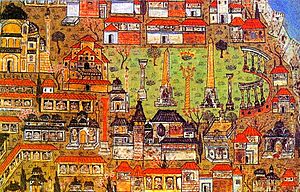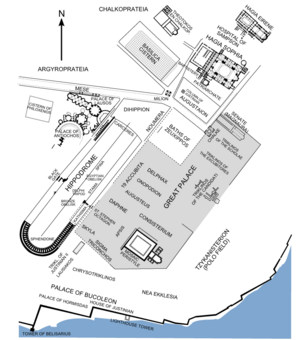Chalke facts for kids
The Chalke Gate was the main entrance to the Great Palace of Constantinople in the Byzantine Empire. Constantinople was a very important city long ago. The gate's name means "the Bronze Gate." It got this name either because its doors were made of bronze or because its roof had shiny, gilded bronze tiles.
Inside, the Chalke Gate was beautifully decorated with colorful marble and amazing mosaics (pictures made from small pieces of colored stone or glass). Outside, it had many statues. One of the most important statues was an image of Christ. This image became a very important symbol during a time called the Byzantine Iconoclasm, when people disagreed about using religious pictures. A small church, called the Christ Chalkites chapel, was built next to the gate in the 10th century. The gate itself was likely taken down in the 13th century, but the chapel lasted until the early 1800s.
History of the Gate
The Chalke Gate was located at the southeast corner of the Augustaion, which was the main public square in Constantinople. The famous Hagia Sophia cathedral was to the north, and the Baths of Zeuxippos and the Hippodrome of Constantinople (a large stadium for chariot races) were to the south and west.
The first building in this spot was built by an architect named Aetherius. This happened during the rule of Emperor Anastasius I (who ruled from 491 to 518). It was built to celebrate a victory in the Isaurian War. Like many buildings in the city center, this first structure burned down during the Nika riots in 532. These riots were huge protests that caused a lot of damage.
After the riots, Emperor Justinian I (who ruled from 527 to 565) rebuilt the gate. A historian named Procopius wrote a lot about this new building in his book De Aedificiis. In the 600s and 700s, the Chalke Gate or its nearby buildings were used as a prison. Later, Emperor Basil I (who ruled from 867 to 886) fixed it up and turned it into a law court, a place where legal cases were heard.
Emperor Romanos I Lekapenos (who ruled from 920 to 944) added a small chapel dedicated to Christ Chalkites next to the gate. This chapel was later rebuilt even grander by Emperor John I Tzimiskes (who ruled from 969 to 976). He also placed special holy items inside it and was buried there himself. This rebuilding was easier because the previous emperor, Nikephoros II Phokas (who ruled from 963 to 969), had built a new, smaller wall around the palace, so the Chalke Gate was no longer part of the main palace wall.
The main gatehouse, which had its bronze doors removed by Emperor Isaac II Angelos (during his first rule from 1185 to 1195), isn't mentioned by Byzantine historians after about 1200. However, the chapel lasted much longer. Russian travelers in the 1300s said it was still mostly standing. Later, during the Ottoman period, the chapel's ruins were known as Arslanhane and were used as a place to keep wild animals. Drawings from the 1700s show the chapel's remains, but it was finally torn down in 1804.
What the Gate Looked Like
We know about the Chalke Gate from several old writings. Procopius's description is the earliest and most detailed. Other writings, like the Parastaseis syntomoi chronikai, tell us about the statues that decorated the gate's front.

Justinian's Chalke Gate was a rectangular building. It had four strong pillars that held up a central dome, a rounded roof. This dome rested on four curved arches, which was a common style in Byzantine architecture. The central part of the building had two smaller rooms on each side, also with curved roofs. It's not completely clear how the Church of Christ Chalkites was connected to the gate. Some think it was to the left, while others believe it was built right on top of the gatehouse. We do know the chapel was on a raised platform, and 18th-century drawings show it about 100 meters southeast of the Hagia Sophia.
Procopius also described the inside of the entrance hall. The walls were covered with slabs of colorful marble. The ceilings were decorated with mosaics. These mosaics showed Emperor Justinian and his wife Theodora with the Byzantine Senate (a group of important officials). They also showed the victories of General Belisarius in wars against the Vandals and Goths, and his triumphant return with treasures, defeated kings, and new lands for the emperor.
Less is known about the outside decorations. However, the Parastaseis syntomoi mentions various statues, probably placed in special spots above the main doorway. These included statues of Emperor Maurice (who ruled from 582 to 602) and his family. There were also two statues of philosophers from Athens, reaching their arms towards each other. Other statues included Emperor Zeno (who ruled from 474 to 491) and Empress Ariadne. Four gorgon heads (mythical creatures, like Medusa) from the Temple of Artemis at Ephesus were also there, placed around the Chalke Gate with a cross symbol above them. The same text also says that statues of Emperor Maximian (who ruled from 285 to 305) and the whole House of Theodosius (a ruling family) were "nearby." The exact spot of a statue of Empress Pulcheria near the building is not clear.
The Icon of Christ Chalkites
Above the main entrance of the Chalke Gate, there was an important religious picture of Christ. It was called the Christ Chalkites ("Christ of the Chalke"). We don't know exactly when this icon first appeared. It might have existed around 600 AD, based on mentions in the Parastaseis. Because it was displayed so prominently at the entrance to the emperor's palace, it became one of the city's most important religious symbols.
Because of its importance, when Emperor Leo III the Isaurian (who ruled from 717 to 741) had it removed in 726 or 730, it caused a huge stir. This act was a major political statement and led to violent protests in the city. It also marked the beginning of the Byzantine Iconoclasm, a time when the official use of religious pictures was forbidden in the Empire.
The icon was put back in place for the first time by Empress Eirene around 787. But then, Emperor Leo V the Armenian (who ruled from 813 to 820) removed it again and replaced it with a simple cross. After the final return of the use of icons in 843, known as the Triumph of Orthodoxy, a new mosaic icon was created by the famous monk and artist Lazaros and placed there.
We don't know exactly what the icon looked like. Early descriptions suggest it might have been a picture of Christ from the chest up, known as a Christ Pantocrator type. However, later Byzantine writings and images, like coins from John III Vatatzes (who ruled from 1221 to 1254) and a mosaic in the Chora Church, use the term for pictures of a standing Christ on a platform.



